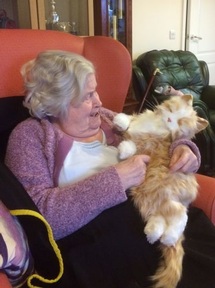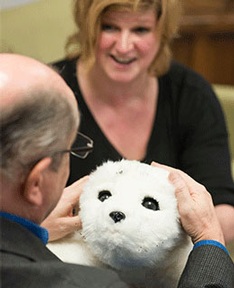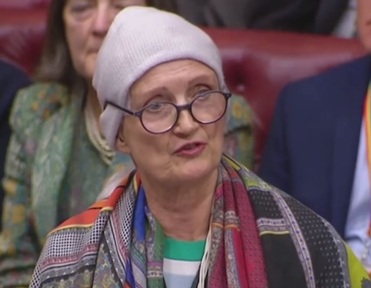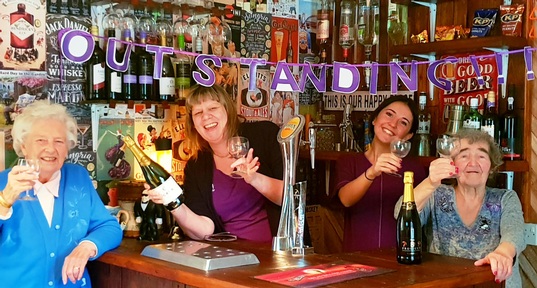Robotic dogs offer comfort and cuddles to care home residents
Eighteen care homes in the south east of England now have their own robotic therapy pet puppies, after a trial found they triggered conversation and social interaction and reduced stress and anxiety in residents.

The care homes in Christchurch, Poole, Bournemouth and St Ives near Ringwood now all have their own pet puppy that responds to touch and speech.
in Bournemouth trialled the robotic dog called Biscuit which makes lifelike movements, earlier this year. He is battery powered and barks and cocks his ears which prompt the residents to talk to him and stroke him.
Deanna Barnes, manager of the home, said: “We have a gentleman that is on end of life care. I took the dog in to show him and normally the man is quite still in his bed. But he actually raised his hand, he was stroking the dog. His whole face changed.
“For my residents it has brought happiness and comfort, reminiscence and a friend.”
Susan Willoughby, chief executive at Care South, said: “At Care South, we are continually looking at ways to embrace technology and evolve and enhance the care we provide to our residents, offering the best quality care to help them feel relaxed and most importantly, at home.
“We were very impressed with the results we saw from the introduction of the robotic dog at Templeman House so were keen to be able to offer the same experience to residents at all our homes.”
Robotic pets are becoming increasingly used in care homes in the UK after research showed they improved the wellbeing of people with dementia.

Researchers at Wrexham Glendwr University have been looking at the impact of ‘robocats’ on people with dementia. Dr Joanne Pike, a senior lecturer in nursing, came up with the idea for the project, after her mum who had Alzheimer’s was given a robotic pet.
“I remember how mum would brighten up and her eyes sparkle when she talked to it,” said Dr Pike.
“She loved cats as we used to have them when she was younger, so she was familiar with them. The robotic companion had an identity, it reminded her of the past and made her smile.
“Towards her later days, even if she didn’t talk to us she would be talking to the cat and stroking it. Mum felt comfort in that, it made her come alive.”
At Brighton University, researchers have been looking at the impact of the robotic seal PARO.
It was found that although the furry seal PARO may be seen as a hard to clean device leading to infection prevention issues in a hospital environment, it brought comfort to people with dementia.
Hygiene and cleaning tests were carried out over nine months by Dr Kathy Martyn at the University’s School of Health Sciences, on a 10-bed dementia ward run by Sussex Partnership NHS Foundation Trust. The results showed PARO was maintained within acceptable limits for NHS Infection Control.

Lead researcher Dr Penny Dodds, who recently moved from the University to the charity Dementia UK, said: "We have demonstrated that, under controlled conditions, PARO was safe within the hospital setting for an acute care dementia unit. It is hoped that this can allay concerns from those who have been hesitant about using PARO in the NHS."
PARO was invented by Professor Takanori Shibata from Japan and studies showed the seal lessens stress and anxiety, promotes social interaction, facilitates emotional expression, and improves mood and speech fluency.
PARO has built-in sensors and its artificial intelligence allows it to ‘learn’ and respond to names patients give it. It also reacts to being stroked and spoken to. It wriggles, turns to the patient, opens its big eyes and lets out a cute, appealing squeak.
PARO has just been launched in the UK by Sense Medical as a certified medical device.
Now in its eighth generation, Paro has been enhancing patient engagement in care homes in Japan and throughout Europe since 2005, and was introduced to the US in 2009 where it gained certification as a medical advice by the US Food & Drug Administration.
Sense Medical’s sales and marketing director, Abdul Jahangir, said: “Our initial focus will be on addressing the needs of residential and nursing care homes and hospitals, where the cost of Paro can be reimbursed by the Government, but Paro is also available to carers looking after loved ones at home.”
Latest Innovative Care News
 13-May-19
'Pink drink' brain cancer treatment rolled out across NHS in memory of Baroness Jowell
13-May-19
'Pink drink' brain cancer treatment rolled out across NHS in memory of Baroness Jowell
 25-Apr-19
Louis Tomlinson helps 83-year-old who lost wife to dementia complete bucket list
25-Apr-19
Louis Tomlinson helps 83-year-old who lost wife to dementia complete bucket list
 22-Mar-19
UK's top care home handyman takes residents to pub for pie and pint
22-Mar-19
UK's top care home handyman takes residents to pub for pie and pint
 12-Feb-19
Michael McIntyre's jokes tested to see if they stop elderly catching flu
12-Feb-19
Michael McIntyre's jokes tested to see if they stop elderly catching flu
 07-Jan-19
'We were lucky to find it': Family's delight as care home is rated Outstanding
07-Jan-19
'We were lucky to find it': Family's delight as care home is rated Outstanding